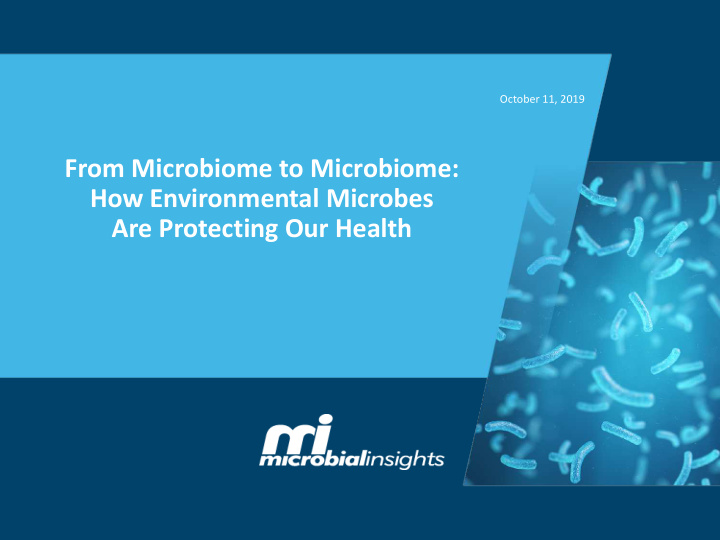



October 11, 2019 From Microbiome to Microbiome: How Environmental Microbes Are Protecting Our Health
Human Health and the Gut Microbiome • Estimated 10 - 100 trillion microbial cells in the human gut microbiota • Potentially exceeding the estimated 10 trillion cells that comprise the human body • 3.3 million nonredundant microbial genes • 150x greater than the total number of genes encoded in the human genome
Relationship to health The gut microbiota composition can be an indicator of: • BMI • blood glucose levels • cholesterol levels • cardiac health Our microbiota is not only our first line of defense against disease but can also be used as an indicator of health status and disease susceptibility .
Microbial Insights Environmental Biotechnology laboratory • Founded in 1992 as a technology transfer • Specialize in molecular biological tools (MBTs) • >27 Years Experience • Accuracy & Precision • QAQC • Continuous Innovation • Dr. David C. White University of Tennessee
That’s why we care.
Molecular Biological Analysis
qPCR Rapidly detect and quantify a target gene or microbial population qPCR Amplification • • Primers & probe bind to target gene • Fluorescence signal increase proportional to concentration Two main types of target genes • Taxonomic (16S rRNA gene) • Functional (e.g. Benzene carboxylase) •
CENSUS qPCR Approach DHC Sample DNA Collection Extraction BVC VCR
Petroleum Hydrocarbons Numerous pathways – many are unknown • Toluene Fuentes, S. et al. Appl Microbiol Biotechnol (2014) 98:4781.
Petroleum Hydrocarbons • More research is needed to identify key players Fuentes, S. et al. Appl Microbiol Biotechnol (2014) 98:4781.
Effect of gut microbiome on toxins • Polyaromatic hydrocarbons converted to estrogenic metabolites in the colon: • Naphthalene • Phenanthrene • Pyrene • Benzo(a)pyrene
Effect of gut microbiome on toxins Sulfonation, methylation, oxidation, reduction: The microbiota dictates how a toxin in modulated within the gut • Different people, different microbiota, different conversions of the toxin Bioavailability changes • Certain gut microbes can methylate mercury, making it more toxic and easier to absorb • Some microbes can reduce the uptake of toxic elements
QuantArray Approach TOD DNA SubArray Sample RMO Extraction Amplification Collection RDEG PHE NAH NAG PHN
Microbial Insights Database – Adding Context YOU ARE HERE
Bio-Traps - 3-4 mm in diameter - 25% Nomex and 75% PAC - 74% porosity - 600 m 2 of surface area/g - Heat sterilized at 270 º C - Colonized by native microbes
Stable Isotope Probing (SIP)
Stable Isotope Probing (SIP) Residual 13 C-Compound Local relative rate 13 C/ 12 C Dissolved Inorganic Carbon Mineralization (C for energy ) 13 C/ 12 C of Biomarkers PLFA Metabolism DNA (C for growth) RNA
Next Generation Sequencing
Hierarchical Clustering - Biodiversity
The effect of toxins on the gut microbiome Changes in diversity matter • Cadmium, arsenic and lead • Gut microbial diversity significantly changed • Herbicides in mice • Depression and anxiety symptoms that correlate with changes in the gut microbiota Human and Mouse Intestinal Microbiota
Chlorinated Solvents Stall? VC is more toxic! Dehalococcoides mccartyi Geobacter lovleyi, Dehalobacter, Sulfurospirillum, Desulfuromonas, Desulfitobacterium Löffler et al. 2013, IJSEM, 63:625 He et al. 2003, Nature, 424:62
Compound Specific Isotope Analysis Contaminant degradation = breaking bonds (Parent compound) (Daughter product)
Isotope Fractionation 12 C bonds tend to break more readily than 13 C bonds. Throughout degradation, 13 C/ 12 C ratio increases. VS Proof of degradation • Degradation mechanism information • Source delineation •
The future of MBTs
Data gaps – how can we do better? • qPCR and QuantArray provide quantitative data for microbes and gene targets What about activity? o • NGS can provide a bigger picture of the overall microbiome What about the health of the microbiome? o • CSIA and SIP provide proof that a contaminant is being degraded What about predicting future degradation trends? o
Metabolomics
Metabolomics Analysis of all small molecules (MW <1100) within an environmental sample • Identification of 80 – 100 known compounds • Thousands of unknown compounds • Comparison of the overall metabolic profile • Statistical Analysis and pattern recognition • Predictive capabilities • Activity of key degraders
SBIR Metabolomics Study RT: 0.00 - 25.02 18.37 100 18.21 90 11.66 12.19 18.46 80 70 11.03 17.68 13.78 60 18.81 50 10.28 16.75 0.91 40 6.01 18.94 30 16.35 19.71 8.37 9.32 14.15 6.43 1.25 19.91 20 15.11 5.58 5.36 20.30 21.56 22.28 10 4.35 2.69 0 0 2 4 6 8 10 12 14 16 18 20 22 24 Time (min)
SBIR Metabolomics Study Active Component Z (7%) ti t0 t1 t2 t3 Inactive t4 tx Slowing? t5 Component Z (6.6%) ) % 4 Inactive & . 8 ( Y C o t ti m n e p o n n o e p n m t X Startup o ( t0 9 C . 9 % ) t1 Active cis-DCE t2 t3 t4 Active t5 ) % 3 . 0 1 ( Y C o t n m e p o n n o e n p t m X o ( 7 C . 7 % ) Vinyl chloride
Where is bioremediation headed? Th The f future re o of f biore bio remedia iatio ion? n? PL PLFA qP qPCR R SI SIP CS CSIA A Gen Genomics s s s c c m m i i e e o o o o t t r r P P Metabolomics Me
Thank you for your time Are there any questions?
Recommend
More recommend